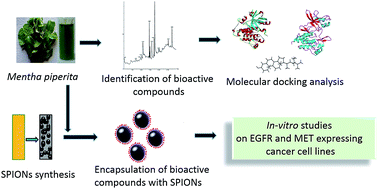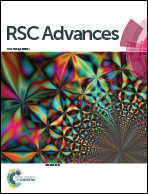Simultaneous inhibition of EGFR and MET receptors with phytochemical conjugated magnetic nanocarriers: in silico and in vitro study†
Abstract
Cross talk between Epidermal Growth Factor Receptor (EGFR) and hepatocyte growth factor or MET receptor has turned out to be a major challenge in cancer treatment. Inhibitors targeting both receptors, when expressed at elevated levels, can significantly reduce cancer cell progression. In the present work, methanolic extract (of Mentha piperita) coated super-paramagnetic iron oxide nanoparticles (SPIONs) were prepared and tested for effective inhibition of EGFR and MET receptors. Extract encapsulated SPIONs (20 ± 5 nm) showed high stability (zeta potential −62.9 mV), antioxidant activity (96% at 1 mg ml−1) and non-haemolytic activity (upto 2.5 mg ml−1). Dose dependent inhibition of EGF and MET receptors by encapsulated SPIONs (IC50 = 67 μg ml−1) was three-fold higher when compared to Mentha piperita extract. Molecular docking analysis with identified bioactive compounds revealed lowest binding energies for 1,3,8-P-menthatriene (−7.89 and −6.59 kcal mol−1), DL-alpha-tocopherol (−7.32 and −5.98 kcal mol−1) and β-sitosterol (−9.22 and −6.27 kcal mol−1) towards EGFR and MET receptors, respectively. Hydrophobic interactions were found to be crucial for the best docked ligands' (β-sitosterol, 1,3,8-P-menthatriene and DL-alpha-tocopherol) mediated EGFR/MET inhibition, irrespective of their hydrogen bonding.


 Please wait while we load your content...
Please wait while we load your content...